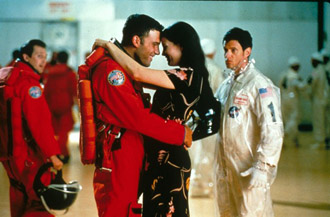Sole Criterion: The Rock and Armageddon
By Brett Ballard-Beach
September 27, 2012
Armageddon, as with the Bad Boys franchise, suffers from a big black hole (pun intended) where there should be an attention-grabbing bad guy. The chief problem with Armageddon is that the “bad guy” is the asteroid and for all the design that went into creating that massive “rock” in a tricked out soundstage in California, it never comes close to satisfying. Efforts to anthropomorphize it, and supply it with a personality, fail. When the shuttles attempt to land on its surface, and later as the crew struggle to drill down to the core as their time frame goes down to the wire, any sense of the dimensions, the geography, or the alien nature of the terrain is missing. The cheap thrills come from attempting implausible maneuvering through trailing fields of rock debris or dodging flying rock debris down on the asteroid itself. The majority of these moments are focused on the faces of the cast. Many of them look convincingly agitated (in both senses of the word) trembling and shaking in their space uniforms strapped into their seats, but the sound and fury has to do the lion’s share of creating any dynamic tension. This dissipates immediately upon first exposure, leaving nothing for future viewings.
There are two sequences in Armageddon worthy of a little closer discussion (similar moments also appear in Pearl Harbor, and the two would make for a painfully bloated, mawkishly sentimental, but telling double feature on American jingoism and patriotism, and the stories we tell about ourselves.) At about the hour mark and again at the two and a quarter hour point, a sequence of images is used to convey first the apprehension of the world at the start of the mission to blow up the asteroid and then the ebullience once it has succeeded. These may be at the heart of the Michael Bay experience, although it is very likely they were second unit work. These images cut through all the bluster of the film and settle on some primal level, subconscious and subliminal. And yet in contradistinction, they also brazenly announce themselves, like Polaroids from another era that instead of fading retain their vibrancy, creating a dizzying and unnerving effect.
The best way I can describe their visceral effect and impact (in conjuring them up, I can almost feel their psychic weight settling on my shoulders) would be “Norman Rockwell, reinterpreted by Leni Riefenstahl.” In slower-but-not-quite-slow-mo, Bay finds two-second Americana vignettes that seem culled from that particular place that some people seem to be referencing when they talk about “the real America” or “the America that used to be.” In a brick building, people edge out and point towards the sky, all but dwarfed and consumed by the Stars and Stripes in front of the windows (a flag as powerful and frightening as the one that billows in the breeze at the end of Nashville). A boy in motion propels a space shuttle model around the corner of a main street drug store, an empty dusty road unfolding behind him. A child holds a transistor radio to his ear, shielding his eye from the overhead sky, and then gestures confidently and amazedly towards the heavens. There is no violence, no action, no explosions just the calm after the storm as a world dusts itself off, rises from below the frame as the camera tracks to the right, and heads off into the future - but just a little bit - to find a place where strippers and firearms and explosions say all that needs to be said.
Continued:
1
2
3
4




